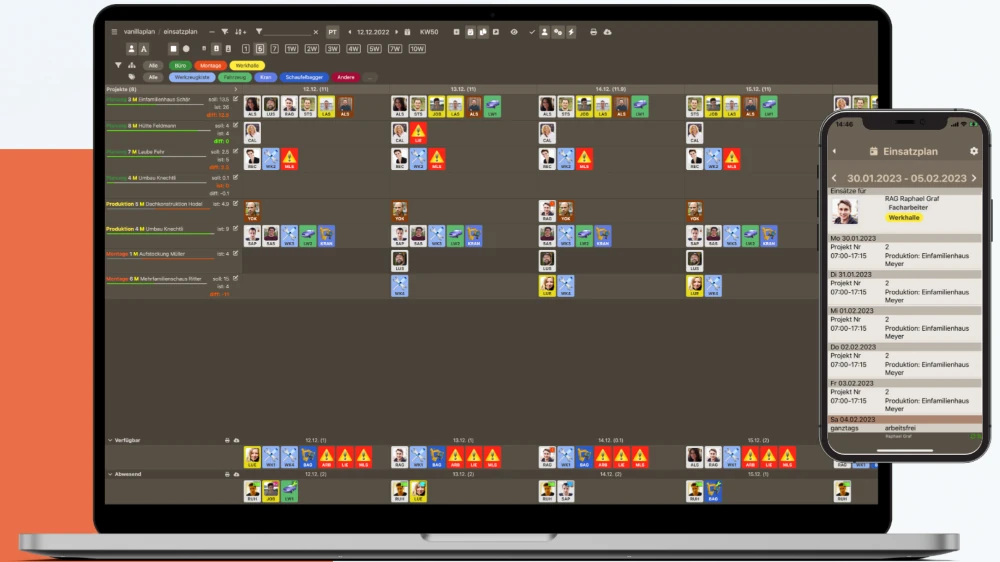Many construction companies use Excel for their resource and capacity planning because it is a simple and cost-effective solution. As a tool that provides extensive functions for calculating and processing data that can be visualised using diagrams and graphs, the possible uses are basically open-ended and complex planning views can be created with sufficient time, will and skill.
Resource planning in Excel
In order to be able to map a complete resource plan in Excel, several planning views should be created. As Excel does not offer a template for resource and capacity plans that covers all areas, we have separated the planning into Gantt charts for capacity planning, absence and resource plans.
Capacity planning
Gantt charts can be useful for rough project planning and communication with key project participants. Gantt charts show the project duration in the form of bars and thus provide a quick overview of ongoing projects and tasks. In the Microsoft Office suite, you will find templates where you can enter the project weeks in the horizontal axis and your projects in the vertical axis. You can indicate the project duration by colour-coding the cells.
So that you can use your Gantt chart as strategic capacity planning, you must also enter the required effort in the cells. In the bottom row, you can add up the values of all cells - and therefore the calculated total effort - and compare them with the available workload. This gives you the future capacity utilisation of your company. One disadvantage here, however, is that you have to fill in many cells manually and update them constantly, which makes the planning prone to errors and requires a lot of maintenance.
Absence planning
Knowing when which employees are available is an important prerequisite for the shift plan and the earlier the dates are known, the lower the number of shifts later on. You will also find templates for the absence plan in the Office Suite, which are structured in a similar way to the capacity planning. You can use the horizontal axis to record the days of the month and the vertical axis to record your resources. The reasons for absence can be entered as letters in the cells and can be highlighted in colour.
The absences are totalled in the bottom row. Here too, the manual entry of all values makes planning quite time-consuming and error-prone. In addition, only full-day absences are possible in this template. The more information is to be included and displayed, the greater the planning effort and the more the template needs to be customised.
Operational planning
The design of the shift plan depends on how detailed you want to plan the working times of your available resources. One option is to display a table for each day of the week with one-hour time intervals along the horizontal axis and the employees along the vertical axis. You can colour-code the project assignments as cells and select an individual colour for each project. Alternatively, you can also display projects along the vertical axis instead of personnel and mark the personnel - in different colours - above the cells.
Cell functions can be used to totalise the working time for each project and each employee. As with planning, you also have to enter a lot of data manually here. In addition, you only have a single view, e.g. in this case only a daily view, organised by employee on the vertical axis, so that you do not have an overview over several weeks, for example.
Communication
As soon as the schedule has been created, it can be sent to employees by e-mail. This ensures that everyone is informed about their planned working hours. This procedure becomes problematic when there are changes, as these often only affect individual employees. If changes are communicated to the entire workforce, this results in a flood of information. If the change is only communicated to the person concerned, it is difficult to maintain an overview.
Excel is useful if...
Excel can be useful as a first step or if you don't need to coordinate a lot of staff and projects. However, as soon as your planning becomes more complex and you have to manage various projects with several participants, Excel quickly reaches its limits.
With Vanillaplan you have some decisive advantages:
1.) A solution that includes everything you need
Although Excel offers extensive options for creating a wide variety of planning views, you have to create them completely yourself. The more detailed and complex you want your planning to be, the more you have to modify the templates, which only cover absolute basic variants. In addition to a high initial outlay, this also results in a constantly high maintenance effort. With Vanillaplan, you have software that contains everything you need right from the start. You register, import your master data and off you go.
2.) A centralised tool for linked planning
You need several planning views for effective resource planning. You can create these in Excel, but they are not linked to each other. This makes it difficult to coordinate your resource planning with the company's capacities, resulting in significantly less optimal utilisation. In Vanillaplan, you have views for capacity planning, two shift plans and an absence plan, each in different time horizons, which are all linked to each other. This allows you to calculate your long-term capacity utilisation, identify staff or order bottlenecks at an early stage, postpone projects quickly and efficiently and adjust your resource planning to your available capacity.
3.) From the construction industry for the construction industry - with certain extra functions
With a little time and effort, you can expand the planning templates in Excel to suit your requirements. With Vanillaplan, on the other hand, you have a wide range of extra functions that are specially adapted to the needs of the construction industry. Various filter options that can be saved to your own profiles, an event function for material deliveries, for example, or the deadline collision message so that you don't schedule anyone twice - these extras will make your work easier on a daily basis.
There are also special functions for different project phases: In production planning, for example, the completion of your order is automatically adjusted to the number of scheduled employees or you can, for example, schedule all orders alined to keep machine utilisation constant.
4.) Project progress at a glance - through resource consumption
One of the most important questions for any construction planning is how the project is progressing. Vanillaplan has a special function for this, for which there is nothing comparable in Excel, namely resource consumption. This shows you for each project whether it exceeds or falls short of the calculated expenditure. This allows you to keep a constant eye on the progress of the project and take measures at an early stage to ensure that the order is completed on time.
5.) Plan individually and together
In Excel, it is possible to share your planning with your employees via the cloud so that everyone can edit it and see each other's changes directly. However, it is not possible to create individual profiles or set different authorisations. In Vanillaplan, you can record all users and create an individual profile for each one, in which they can save their filter options or other personal settings, for example. You can also set the extent to which each user can edit the planning or just read it, for example, so that different employees can contribute to the planning at different levels.
6.) Simple communication - with display board and mobile app
Once the shift plan has been created, it must be communicated to the employees. If planning is done in Excel, it is a good idea to send the plan to all employees by email. However, it becomes really time-consuming - and this is often the case - when spontaneous changes arise that certain employees need to be informed about promptly. With Vanillaplan, the display board and mobile app as a means of communication put an end to sending out schedules and making follow-up calls: your employees can see where they are allocated the following day on the display board the day before, or can read it from home or on the move in the mobile app. They can also be quickly informed of changes via the mobile app using push notifications - and only if the changes are relevant to them.
7.) Visual and intuitive operation
You can use different colours, abbreviations or symbols in Excel to make your planning as clear as possible. However, this becomes difficult with really complex plans. With Vanillaplan, we have specialised in simple, clear presentation and intuitive operation. With colours, icons, photos and diagrams, you can get an overview of your planning in a matter of seconds. It is easy to use without any initial difficulties and its simple handling saves you time every day.
Conclusion
The costs for Excel may be low and the possible uses are basically open-ended, but you have to invest a lot of time and energy in creating your planning and have a permanently high maintenance effort - and that without specific functions for construction planning.
See for yourself and try out our specialised resource planning software Vanillaplan free of charge and without obligation for 14 days.
FAQs
1. Why do many construction companies use Excel for resource planning?
Many construction companies use Excel because it offers a cost-effective, flexible and easy-to-use solution for resource planning in project management. Excel enables extensive calculations and data visualisation supported by charts and graphs.
2. What are the challenges of resource and capacity planning with Excel?
The challenges of planning with Excel include the high manual maintenance effort, the susceptibility to errors when entering data and the limited options for linking different planning views.
3. What is a Gantt chart and how does it help with capacity planning?
A Gantt chart displays the project duration in the form of bars and provides a quick overview of ongoing projects and tasks. It helps with strategic capacity planning by visualising the required effort and the available capacity.
4 .What are the disadvantages of manual input in Excel for resource planning?
Manual input in Excel is time-consuming and error-prone. It also requires a lot of maintenance, especially if changes need to be made. Planning is usually limited to individual views, which makes it difficult to maintain a clear overview.
5. How does Vanillaplan facilitate communication with employees?
With Vanillaplan, employees can see their schedules on the display board and the mobile app, which means they are always up to date. Spontaneous changes are sent directly to the affected employees via push messages, eliminating time-consuming follow-up phone calls and giving everyone exactly the information they need.
6. How can specialised resource planning software such as Vanillaplan improve planning?
Vanillaplan offers linked planning views, specialised features such as schedule collision notifications and resource consumption, and a user-friendly interface. It reduces the maintenance effort and enables effective resource planning.
7. Can I test Vanillaplan free of charge?
Yes, you can test Vanillaplan free of charge and without obligation for 14 days.




